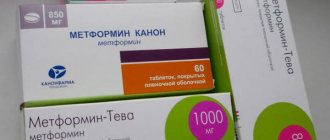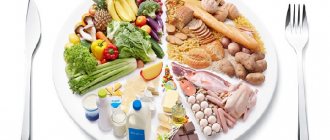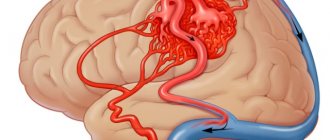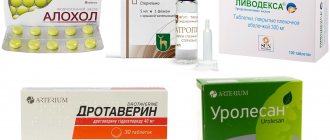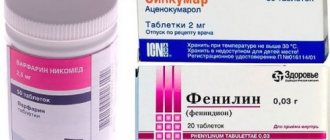For type 2 diabetes, the doctor prescribes a low-carbohydrate diet, optimal sports training, and glucose-lowering pills that help maintain blood glucose levels at the required level.
Currently, there is a large selection of new generation glucose-lowering drugs that must be taken for type 2 diabetes. They all differ in their mechanism of action, have their own indications and contraindications, and negative reactions.
Modern tablets are selected on an individual basis; many factors are taken into account, such as the patient’s age, the “experience” of the pathology, concomitant ailments and existing complications.
The classification of sugar-lowering drugs that are used for type 1 and type 2 diabetes should be considered. To identify which new generation drugs are the most effective, and what is their effectiveness based on?
Meglitinide therapy
The mechanism of action of this category of medications is to stimulate the production of the hormone by the gland. The effectiveness of the drug is directly related to the concentration of sugar. The higher it is, the more hormone will be produced.
The main representatives of this group are NovoNorm and Starlix, which belong to the latest generation of tablets and are characterized by a short effect. You need to take the medicine a couple of minutes before meals.
As a rule, in the vast majority of cases these drugs are recommended as part of complex treatment. They have minor side effects such as abdominal pain, diarrhea, and allergic reactions.
Features of use and dosage of the medicine:
- The dosage of NovoNorm is always selected on an individual basis. Usually prescribed to be taken 3 to 4 times a day, immediately before meals. The drug acts smoothly, so the likelihood of a sharp drop in glucose is reduced to zero.
- The maximum concentration of the active substance of the drug Starlix is observed in the blood 1 hour after taking the tablets. At this time, the maximum effect of the drug is noted, which lasts up to eight hours.
Starlix does not promote weight gain, does not have a negative effect on the function and condition of the kidneys, and does not affect the liver in any way. The dosage of the drug depends on the individual characteristics of the patient and his medical history.
Medicines to lower blood sugar
In 2019, according to statistics from the World Health Organization, people with diabetes among the adult population of the planet accounted for 8.5%. It is no coincidence that scientists around the world have united to create effective drugs against this disease. Antihyperglycemic drugs are drugs created on the basis of chemical substances that can activate the secretion of insulin by the pancreas, slow down the production of glucose by the liver, or activate the use of sugar by the tissues of the human body.
Treatment with biguanides and thiazolidinediones
Medicines in this group, in particular biguanides, prevent the release of glucose from the liver, while ensuring better absorption and transportation of sugar at the cellular level and in the soft tissues of the human body.
These drugs are never prescribed for the treatment of type 2 diabetes mellitus in patients who have a history of renal or heart failure.
The duration of action of the drugs varies from 6 to 16 hours, and at the same time they do not contribute to sudden changes in glucose in the body. The most common side effects: attacks of nausea, disruption of the digestive tract, changes in taste buds.
From the biguanide group, hypoglycemic drugs for type 2 diabetes, the list is as follows:
- Siofor is the first drug that is recommended for patients with any stage of obesity or large body weight, as it provides weight loss. The maximum dosage per day is three grams, and it must be divided into a couple of doses.
- Metformin helps slow down the absorption of sugar in the intestine and also stimulates its utilization in peripheral tissues. Contraindications: impaired renal function, rehabilitation period after surgery.
The price of the products depends on the manufacturer, the number of tablets in the package and varies from 200 to 300 rubles.
Thiazolidinediones work on the same principle as biguanides. However, their distinctive feature is that they are much more expensive and have a large list of negative effects.
This group can be represented by the following medications:
- Actos can be prescribed as monotherapy to treat type 2 disease. Among the disadvantages of the drug, there is an increase in body weight while taking it.
- Avandia is a medicinal drug whose action is aimed at improving metabolic processes, lowering sugar concentrations, and also increasing tissue sensitivity to insulin.
In the vast majority of cases, Avandia is prescribed as part of a combination treatment, and rarely as a single drug. Use during pregnancy, childhood, and problems with the cardiovascular system is strictly prohibited.
The average price in pharmacies for Avandia is 600-800 rubles. Actos will cost the patient from 3,000 rubles.
Classification of diabetes pills
The principle of treating diabetes is to maintain sugar at a level of 4.0–5.5 mmol/l. To do this, in addition to following a low-carbohydrate diet and regular moderate physical exercise, it is important to take the right medications.
Medicines for the treatment of diabetes mellitus are divided into several main groups.
Sulfonylurea derivatives
These diabetic drugs have a hypoglycemic effect due to their effect on the beta cells responsible for the production of insulin in the pancreas. Drugs in this group reduce the risk of deterioration of kidney function and the development of cardiovascular diseases.
Maninil - affordable tablets for diabetics
List of the best sulfonylurea derivatives:
| Name | Admission rules | Contraindications | Amount | Price, rubles |
| Diabetes | At the beginning of treatment, take 1 tablet per day with meals. In the future, the dosage can be increased to 2–3 pieces per day | Coma, pregnancy, renal and liver failure | 30 | 294 |
| Glyurenorm | The initial dose is 0.5 tablets in the morning with breakfast. Over time, the quantity increases to 4 pieces per day | Childbearing and breastfeeding, coma and precoma, diabetic acidosis | 60 | 412 |
| Maninil | The dose ranges from 0.5 to 3 tablets | Ketoacidosis, hyperosmolar coma, intestinal obstruction, renal and liver failure, pregnancy, leukopenia, infectious diseases | 120 | 143 |
| Amaryl | Drink 1–4 mg of the drug per day, washing down the tablets with plenty of liquid | Impaired liver and kidney function, galactose intolerance, lactase deficiency, pregnancy and lactation, coma | 30 | 314 |
| Glidiab | Take 1 hour before meals, 1 piece in the morning and evening | Intestinal obstruction, leukopenia, severe kidney and liver pathologies, intolerance to gliclazide, bearing and feeding a child, thyroid diseases, alcoholism | 739 |
Sulfonylurea derivatives should not be taken if you have type 1 diabetes. The dosage is calculated taking into account the severity of the disease, the patient’s age and blood glucose levels.
Meglitinides
Medicines for diabetics in this group are similar in therapeutic effect to sulfonylurea derivatives and stimulate the production of insulin. Their effectiveness depends on blood sugar levels.
Novonorm is needed for insulin production
List of good meglitinides:
| Name | Method of administration | Contraindications | Amount | Cost, rubles |
| New norm | Take 0.5 mg of medication 20 minutes before meals. If necessary, the dose is increased once a week to 4 mg | Infectious diseases, diabetic coma and ketoacidosis, bearing and feeding a child, liver dysfunction | 30 | 162 |
| Starlix | Take 1 piece 30 minutes before your main meal | Age under 18 years, pregnancy, lactation, nateglinide intolerance, liver disease | 84 | 2820 |
Meglitinides are not used in the treatment of insulin-dependent diabetes.
Biguanides
Medicines in this group prevent the release of glucose from the liver and promote its better absorption into the body tissues.
A drug for better glucose absorption
The most effective biguanides:
| Name | Method of administration | Contraindications | Amount | Cost, rubles |
| Metformin | Drink 1 piece after meals. The dose can be increased after 10–15 days of treatment to 3 tablets | Age under 15 years, gangrene, precoma, hypersensitivity to drug components, myocardial infarction, lactic acidosis, alcoholism, pregnancy and lactation | 60 | 248 |
| Siofor | Take 1-2 pieces with plenty of water. The maximum daily dose is 6 tablets. Used for weight loss in diabetes mellitus | Type 1 diabetes mellitus, renal, respiratory and liver failure, lactic acidosis, low-calorie diet, chronic alcoholism, bearing and feeding a child, myocardial infarction, recent surgery | 314 | |
| Glucophage | At the beginning of treatment, take 1-2 tablets per day, after 15 days you can increase the dose to 4 tablets per day | 162 |
Metformin is used in the complex treatment of diabetes mellitus types 1 and 2. Biguanides act from 6 to 16 hours - during this period of time the absorption of fat and glucose from the intestinal tract decreases. These medications slow down the development of complications and significantly reduce the risk of developing cardiovascular diseases.
Thiazolidinediones
They are characterized by the same effects on the body as biguanides. The main difference is the higher cost and an impressive list of side effects.
An expensive and effective drug for glucose absorption
These include:
| Name | Admission rules | Contraindications | Amount | Price, rubles |
| Avandia | For the first 1.5 months, take 1 tablet per day, then, if necessary, the dose is increased to 2 tablets per day. | Hypersensitivity to rosiglitazone, heart failure, liver disease, galactose intolerance, pregnancy, breastfeeding | 28 | 4820 |
| Aktos | Use 0.5–1 piece per day | Heart disease, age under 18 years, intolerance to drug ingredients, ketoacidosis, pregnancy | 3380 | |
| Pioglar | Take 1 tablet per day, regardless of meals | Pioglitazone intolerance, ketoacidosis, pregnancy | 30 | 428 |
Thiazolidinediones do not have a positive effect in the treatment of type 1 diabetes mellitus.
Gliptins
New generation medications that help increase insulin production and release sugar from the liver.
Galvus is needed to release sugar from the liver
List of effective gliptins:
| Name | Instructions | Contraindications | Amount | Price, rubles |
| Januvia | Take 1 tablet per day at any time | Age under 18 years, intolerance to the drug components, pregnancy and lactation, type 1 diabetes mellitus, heart, kidney and liver failure | 28 | 1754 |
| Galvus | Take 1–2 pieces per day | 812 |
Important!
Gliptins cause minimal side effects, do not contribute to excess weight gain, and reduce glucose levels without negatively affecting the pancreas.
Januvia to lower blood glucose
Alpha glucosidase inhibitors
These modern antidiabetic drugs prevent the production of an enzyme that dissolves complex carbohydrates, thereby reducing the rate of absorption of polysaccharides. Inhibitors are characterized by a minimum of side effects and are safe for the body.
These include:
| Name | Instructions | Contraindications | Amount | Cost, rubles |
| Glucobay | Drink 1 piece 3 times a day before meals | Diseases of the stomach and intestines, deterioration of the digestive tract, pregnancy, lactation, age under 18 years, ulcer, hernia | 30 | 712 |
| Miglitol | At the beginning of therapy, 1 tablet before bedtime; if necessary, the dose is increased to 6 tablets, divided into 3 doses. | 846 |
The above medications can be taken in combination with medications from other groups and insulin.
Sodium-glucose cotransporter inhibitors
Latest generation drugs that effectively lower blood sugar. Medicines in this group cause the kidneys to excrete glucose through the urine at a time when the blood sugar concentration is from 6 to 8 mmol/l.
Imported drug to lower blood sugar
List of effective gliflozins:
| Name | Method of administration | Contraindications | Amount | Cost, rubles |
| Forxiga | Drink 1 piece per day | Heart disease, myocardial infarction, alcohol intoxication, type 1 diabetes mellitus, pregnancy, lactation, metabolic acidosis, lactase intolerance and deficiency | 30 | 3625 |
| Jardines | Take 1 tablet per day. If necessary, the dose is increased to 2 pieces | 2690 |
When taking the above medications, there is often an increase in trips to the toilet, dehydration and a noticeable decrease in blood pressure.
Combination drugs
Medicines containing metformin and gliptins. List of the best combination type products:
| Name | Method of administration | Contraindications | Amount | Cost, rubles |
| Janumet | Take 2 times a day, 1 tablet with meals. | Pregnancy, breastfeeding, type 1 diabetes mellitus, kidney dysfunction, alcoholism, intolerance to drug components | 56 | 2920 |
| Galvus Met | 30 | 1512 |
Do not take combination products unless necessary - try to give preference to safer biguanides.
Combination remedy for diabetics
Alpha-glucosidase inhibitors
These diabetes medications help block a special intestinal enzyme that helps dissolve complex carbohydrates. Thanks to this, the process of absorption of polysaccharides becomes much slower.
Alpha-glucosidase inhibitors are modern medications for lowering blood sugar that have virtually no negative effects and do not cause disruption of the digestive and gastrointestinal tract.
The tablets should be taken immediately with the first sip of food. Reviews from patients show that the medicine effectively copes with the task of lowering blood sugar, while there is no effect on the pancreas.
Medicines belonging to this category can be successfully combined with other sugar-lowering tablets, as well as insulin. However, this increases the likelihood of developing hypoglycemia.
The most popular and effective representatives of this group:
- Glucobay is prescribed when there is a sharp jump in sugar immediately after eating. It is well tolerated by patients and does not affect body weight. The tablets are recommended as an adjuvant treatment to complement a low carbohydrate diet. The maximum dose per day is 300 mg, which is divided into three applications.
- Miglitol is a medication prescribed for the treatment of type 2 diabetes when diet and physical activity do not produce the required therapeutic effect.
The dosage of Miglitol is selected individually, in principle, as is the frequency of its use. It should not be prescribed during pregnancy, in childhood, for chronic diseases of the gastrointestinal tract, or in the presence of large hernias.
The price for Glucobay varies from 500 to 800 rubles, Miglitol costs approximately 600 rubles.
Other medicines used by diabetics
As has been repeatedly noted, the “war” against type 2 diabetes is being waged in all directions, not limited only to glucose-lowering medicine.
To avoid side effects and to generally strengthen the functional abilities of the body, doctors use drugs for various purposes:
- Combating high blood pressure with antihypertensive drugs.
- Strengthening the heart muscles and blood vessels – cardio- and vasotonics.
- Enzymatic agents for balanced functioning of the gastrointestinal tract: probiotics – specially bred bacteria and prebiotics – “food” for probiotics.
- Painkillers and anticonvulsants. These funds are necessary to neutralize polyneuropathy, a complication of diabetes.
- Anticoagulants are medications that block thrombus-forming manifestations.
- To restore metabolism (metabolic processes), fibrates and statins are prescribed.
Important! Experienced and qualified endocrinologists, in conjunction with basic medications, prescribe biologically active additives (BAA) and nephroprotectors - medications that ensure the preservation of kidney function.
Combined
In the sections of the article where the main drug groups were considered, it was emphasized that sometimes the exclusive (mono) use of drugs of one type does not give the desired result.
Scientists have concluded that combination drugs are effective. This solution made it possible to enhance the therapeutic effect, affecting different points of the body, and also reduce side effects.
Examples of such successful combinations can be seen in the table:
| Name and combination composition | Features of the impact |
| Amaryl M: Metformin + Glimepiride | All medications contain sulfonylureas and metformin. The former activate the release of insulin from beta cells, metmorphine, in turn, increases the sensitivity of tissues to insulin and liver-produced glucose. |
| Glimecomb: Gliclazide + Metformin. | |
| Glibomet, Gluconorm, Glucovance: Glibenclamide + Metformin. | |
| Janumet: Metformin + Sitagliptin. | The complementary combination presented in the two drugs enhances the therapeutic effect. Blockers (inhibitors), which is Sitagliptin, successfully harmonizes with Metformin, which improves metabolism in the body. |
| Galvus Met: Vildagliptin + Metformin. |
Medicines for elderly diabetics
For effective treatment of diabetes in elderly and elderly patients, in addition to the medicinal effect on the disease, it is necessary to include two accompanying motivational programs:
- Refusal of high-calorie foods.
- Incorporating feasible physical activity into your daily routine.
In addition, medications from the following groups are used for complex treatment:
- Biguanides: Siofor, Metfogamma, Glucophage, Avandamet, Bagomet.
- Sulfonylurea derivatives: Gliclazide, Glimepiride, Gliquidone, Glipizide GITS.
- Gliptins: Sitagliptin, Vildagliptin, Saxagliptin.
- Alpha-glucosidase inhibitors: Diastabol, Glucobay.
- Insulin.
Important! When blood sugar levels reach a critical level, an elderly person is prescribed insulin, which brings relief already on the second day after use.
Antihypertensive drugs
Drugs that lower blood pressure are represented by the longest line of all “brothers” of the large medicinal family.
It is arterial hypertension (AH) that is a concomitant pathology of diabetes mellitus. Often its symptoms appear even before the clinical picture of the underlying disease.
The list of drugs that have antihypertensive functions is quite extensive, but not all of them can claim the status of assistants in the treatment of type 2 diabetes - this is all due to the side effects that arise.
Scientists identify five main groups of antihypertensive drugs:
- Diuretics. Loop diuretics and thiazides: Indapamide, Ipothiazide, Chlorthalidone, Edecrine, Lasix. Medicines in this group can only lower blood pressure, but not eliminate cause-and-effect relationships.
- Angiotensin II receptor blockers: Losartan, Micardis - they are similar in action to ACE inhibitors, but are much better tolerated by patients.
- Calcium antagonists: Nifedipine, Verapamil, by expanding the lumen of blood vessels, reduce the likelihood of albuminuria - the release of excess amounts of protein into the urine.
- Angiotensin-converting enzyme inhibitors (ACEI): Enalapril, Captopril - protect the heart and blood vessels, providing a nephroprotective effect.
- Beta-blockers: Nebilet, Carvedol - affect cellular tissue located in the heart and kidneys.
Statins and fibrates
The purpose of this group is difficult to underestimate, because it is an effective remedy in the fight against atherosclerotic vascular damage.
Statins regulate the process of cholesterol formation and resist the appearance of plaques on the inner walls of blood vessels.
List of drugs from the statin group:
- Pitavastatin;
- Simvastatin;
- Lovastatin;
- Pravastatin;
- Ozuvastatin;
- Fluvastatin;
- Atorvastatin.
Important! In the course of medical research, a generalization has been made that the best drugs of the statin group are drugs produced on the basis of rosuvastatin, pitavastatin, atorvastatin and cerivastatin.
Fibrates are concentrated on inhibiting the synthesis of triglycerides - neutral fats - in the liver and removing them from the blood.
These include:
- Lipanor;
- Lipantil;
- Lopid;
- Atromid;
- Atromidine;
- Bezamidine;
- Miscleron;
- Gevilon;
- Traikor;
- Normolit;
- Lipantil;
- Bezalip.
Important! Scientists have noticed that with long-term use, fibrates and statins can significantly reduce the likelihood of heart attacks, especially fatal ones.
Video from Dr. Malysheva:
https://youtu.be/JCT2nzerVyo
New generation medicines
The pharmaceutical industry does not stand still; every year new drugs are synthesized to combat type 2 diabetes. Recently, so-called dipeptidyl peptidase inhibitors have appeared, which help enhance insulin synthesis, but at the same time “focus” on the amount of sugar in the blood.
In any healthy body, more than 75% of the hormone is produced under the influence of specific hormones, which are grouped under the class of incretins.
Such substances trigger a process that helps release glucose from the liver and produce the hormone by pancreatic cells. The newest medications can be used as monotherapy or included in complex treatment.
The medicine should be taken during or after meals. They are well tolerated by patients. Prominent representatives of this group are the following tablets:
- Januvia is a medicine in the form of tablets, coated. The tablets are taken once a day, they do not provoke weight gain, and help maintain normal sugar on an empty stomach, as well as after meals. It is noted that the drug inhibits the progression of pathology and reduces the likelihood of complications.
- Galvus is a medication that stimulates the functionality of the pancreas. It is recommended as a monotherapeutic treatment and complements a health-improving diet and optimal physical activity. Can also be prescribed in combination.
The price of Januvia tablets starts from 3,000 rubles, depending on the manufacturer and the number of tablets in the package, the cost may increase. And for Galvus the price is 800-1600 rubles.
https://youtu.be/_vWZgRNrsSg
Insulin or tablets - which is better for diabetes?
In the treatment of type 1 diabetes mellitus, insulin is used; treatment of uncomplicated type 2 diabetes mellitus is based on taking medications to normalize sugar levels.
Advantages of tablets compared to injections:
- ease of use and storage;
- no discomfort during use;
- natural control of hormone levels.
The advantages of insulin injections are the rapid therapeutic effect and the ability to select the most suitable type of insulin for the patient.
Insulin injections are used by patients with type 2 diabetes mellitus if drug therapy does not have a positive effect and after eating the glucose level rises to 9 mmol/l.
Insulin injections are only used when pills don't help.
https://youtu.be/WDbicAZC9_0
Complete list of oral medications for type 2 diabetes
All medications for the drug treatment of type 2 diabetes can be divided into 4 groups of pharmacological agents:
- drugs that stimulate the pancreas to produce more hormones or secretatos - sulfonylurea derivatives and glinides (meglitinides). Currently, they are considered not only outdated, but also harmful, since they greatly deplete the pancreas;
- medications that increase insulin sensitivity - thiazolidinediones and biguanides. Still the most common pill for diabetics;
- new generation drugs – DPP-4 inhibitors, GLP-1 antagonists and alpha-glucosidase inhibitor;
- combination drugs – metformin + sulfamilurea.
Sulfamilurea drugs are contraindicated for:
- renal failure;
- ketoacidosis;
- pregnancy;
- lactation.
Despite their low price and rapid achievement of effect, they increase the risks of hypoglycemia, rapid development of resistance and contribute to additional weight gain.
Tablets based on meglitinides are characterized by the same contraindications and consequences, but they, in turn, are expensive, and the annotations do not contain information about safety and long-term effectiveness.
A group of secretagogues often does more harm than good and contributes to the aggravation of the hyperglycemic state. Often causes heart attacks, strokes and glycemic coma.
Contact your treating endocrinologist. Nowadays, he will probably cancel the secretagogues, prescribe a new generation drug and select an affordable brand of metformin or Siofor.
The main goal of diabetics with type 2 diabetes is not to stimulate insulin production, but to increase the sensitivity of cells to it.
Compound
The active ingredients in Subetta tablets are in the amount of 0.006 g: antibodies to the C-terminal fragment of the beta subunit of the insulin receptor and to endothelial NO synthase are affinity purified. They are applied to isomalt as a mixture of 3 active aqueous-alcoholic dilutions of the substance, in concentrations of 10012, 10030, 100200 times. Other excipients include crospovidone and magnesium stearate.
Blood sugar is always 3.8 mmol/l
Innovation in diabetes treatment - just drink every day...
>
The drug "Glipizide"
This drug is a second generation sulfonylurea derivative. The drug is able to control glucose levels in insulin-independent diabetes. Tablets of hypoglycemic drugs such as Glipizide have their effect within half an hour after use, and are completely eliminated from the body within a day. Each tablet contains 0.005 grams of active substance.
Please note that the dosage will be selected by the attending physician purely individually, depending on the patient’s condition. Such drugs can be prescribed only after special tests have been completed and the picture of the person’s health status is completely clear. Typically, in the initial stages of treatment, the daily dosage is only one tablet. But if the case turns out to be more advanced, then the doctor may prescribe the use of two or three tablets at a time. The maximum daily dosage should not exceed nine tablets. It is recommended to drink each half an hour before meals.
Side effects of second-generation glucose-lowering drugs are usually not observed. Only some patients complained of dizziness, headaches, weakness throughout the body and fatigue. However, such side effects are very easy to eliminate by just slightly changing the dosage. Typically, such reactions are noticed only in older people.
The new generation of hypoglycemic drugs are designed precisely to improve the condition of patients as much as possible. This product should not be used by pregnant and lactating women, children, or patients suffering from allergic reactions to the components included in the composition.
In what cases should sulfonylurea derivatives not be prescribed?
A condition such as diabetic coma is a very important contraindication to the use of sulfonylurea drugs. Pregnant and lactating women should not take such tablets, regardless of what therapeutic indicators have been achieved before.
As is known, people suffering from type 2 diabetes tolerate surgery very poorly. Therefore, glucose-lowering drugs for type 2 diabetes are canceled. The same applies to infectious diseases. As soon as the patient’s condition returns to normal, the specialist may prescribe him other glucose-lowering pills.
What else you need to know about tablets
Whether or not to take it is still controversial, since they all have side effects and a number of contraindications.
Many doctors and patients are convinced that chemistry cannot be useful to an already suffering, sick body. This is partly true. But if the patient’s condition is unstable, only medications can quickly help him.
You need to be prepared for the following side effects:
- Biguanides - unstable stool, diarrhea, loss of appetite and a feeling of aversion to food, a metallic taste on the tongue, the development of lactic acidosis. Such phenomena can be neutralized with the help of folic acid and B vitamins.
- Sulfonylurea - migraines, tinnitus, skin rashes, development of cholecystic hepatitis and renal failure.
- Carbohydrate blockers - can provoke the formation of gases in the intestines, cause rumbling in the stomach, bloating, and flatulence.
Usually prescribed in pairs:
- two sulfonylureas;
- biguanides and sulfonylureas;
- sulfonylureas and incretins.
If the side effects are pronounced or the patient has an individual intolerance to any drug, it is replaced with an analogue.
Tablets are needed when the patient would like to reduce the number of insulin injections for type 1 diabetes or even completely abandon them. Medicines are indispensable when it is not possible to have a full meal, a person has been subjected to nervous stress or physical overload.
It is the pills that often save the patient’s life. But drugs are not a panacea; you cannot rely only on them and violate the doctor’s instructions. This is an emergency aid only. The main points in the treatment of diabetes mellitus still remain proper nutrition and a healthy lifestyle.
Sugar-lowering drugs are contraindicated if you have kidney and liver diseases, since they are excreted from the body without therapeutic effect. Therefore, when prescribing medications, you need to inform your doctor about this.
Unlike sulfonylureas, biguanides are rarely prescribed for diabetics. Due to the fact that the drugs have many restrictions.
So, they cannot be accepted:
- people over 60 years old;
- with hypoxia;
- for kidney and liver diseases;
- if there is inflammation of an infectious nature.
In addition, they have a number of side effects:
- nausea,
- rash,
- vomit,
- loose stool.
Biguanides also have positive properties; the drugs lower sugar and do not stimulate hunger, which is important for diabetes.
This group of medications reduces the absorption of glucose in the intestine and stabilizes lipid levels. Only a doctor can prescribe tablets from this group.
Inhibitors are prescribed as auxiliary agents, since they do not have a glucose-lowering property, but reduce the absorption of carbohydrates into the intestines, as a result of which sugar does not increase.
At the same time, it is important for the patient not to abuse carbohydrate-containing foods, otherwise complications such as indigestion and diarrhea may occur.
A low-carbohydrate diet and active physical activity help stabilize glycemic levels in patients with type II diabetes mellitus. If these measures are not enough, patients are prescribed medications to reduce high blood sugar. Drug treatment helps normalize metabolism, increases the resistance of peripheral tissues to the hormone insulin, and stimulates the functioning of the pancreas.
Tablets of this group activate receptors of β-cells of the pancreas, releasing reserve reserves of insulin. Sulfonylurea derivatives increase tissue resistance to protein hormones. Most insulin is released after eating.
New generation tablets for effectively reducing high blood sugar in non-insulin-dependent type 2 diabetes, list of drugs:
- Glibenclamide is a second generation sulfonylurea derivative that has hypoglycemic and hypocholesterolemic effects. The drug stimulates the functioning of the islets of Langerhans, increases the resistance of peripheral tissues to insulin, and improves the utilization of glucose from muscles and liver. The drug reduces the level of bad cholesterol, reduces the urge to urinate, and prevents the formation of blood clots. The effect of the drug lasts 8–12 hours. The dosage is selected individually.
- Gliclazide is effective for metabolic disorders and latent diabetes in patients with exogenous obesity. A decrease in hyperglycemia is achieved by stimulating pancreatic β-cells and accelerating the utilization of excess glucose. The drug Gliclazide, which reduces blood sugar and excess weight in type 2 diabetes, protects against the development of cataracts, nephropathy, and blood clots. The drug is used as monotherapy and in combination with insulin injections or other sugar-lowering tablets.
- Another new generation drug for lowering blood sugar in type 2 diabetes is Gliquidone; this drug stimulates the pancreatic islets, causing a backup release of insulin. In addition, the tablets increase tissue sensitivity to the hormone and reduce glucagon levels. Therapy with Gliquidone is carried out in middle-aged and elderly people.
Sulfonylurea derivatives have contraindications for use and may have side effects. Therefore, the medications and dosage are selected by the attending physician, taking into account the individual characteristics and severity of the disease.
Diet
To control blood sugar levels, you need to follow a certain diet. It involves calculating the glycemic index (GI). Products with a low level of carbohydrates are allowed to be eaten with virtually no restrictions, while products with a high level are strictly prohibited. An approximate list of allowed and prohibited foods:
| Category | Authorized Products | Prohibited |
| Vegetables | Garlic, onions, tomatoes, all types of cabbage, cucumbers, green beans, turnips | Canned sweet corn, beets, potatoes, pumpkin |
| Berries | Cherry, strawberry | Watermelon |
| Fruits | Apricots, grapefruit, plums, apples, | Melon, bananas, pineapples |
| Cereals | Barley, peas, lentils, corn, bulgur, oatmeal, buckwheat | Semolina, muesli, instant porridge |
| Sweets | Fructose, dark chocolate, | Raisins, milk chocolate, bars, sugar, waffles |
| Other | Mushrooms, rice bran, bread, natural spaghetti | Buns, biscuits, pasta, cookies, brown bread, wheat flour, dumplings, sauces, spices |
| Dairy | Yogurt | Cheese, full-fat milk, animal fats |
| Protein | Chicken, rabbit. lean veal or beef, quail eggs | Red fatty meat, sausages, fatty salted fish, smoked meats |
| Beverages | Natural juices | Sweet carbonated drinks, beer, wine, kvass |
Benefits of fiber for diabetics
When food containing simple carbohydrates enters the body, they are instantly transformed into sugar. In diabetes mellitus, glucose is produced that is poorly absorbed, leading to a malfunction of the pancreas. If complex carbohydrates (fiber, starch, pectins) are consumed, then absorption slows down, breakdown into glucose does not occur, and the person remains full longer.
Dietary fiber is extremely important in a diabetic diet because it lowers blood glucose levels. When consuming, you should adhere to the rule of 25-40 g of fiber daily; intake should be slow so that the body can process the food completely and does not overload the intestines. Soluble fiber lowers cholesterol levels, slows down the digestion of sugar, and serves as a preventive measure for vascular pathologies. The insoluble type has zero calories and lowers blood pressure and homocysteine levels.
Carbohydrates for type 2 diabetes
The diet of a person with type 2 diabetes should include carbohydrates because they provide energy to the body, but it is important to remember that there are different types of carbohydrates. The most beneficial for a diabetic are considered to be complex ones - fiber, dietary fiber, and the harmful ones are simple ones, which instantly cause a “jump” in glucose. Patients with diabetes should adhere to a low-carbohydrate diet, which does not allow sugar levels to rise, reducing the risk of severe hypoglycemia.
Indications for use
The main reason for taking Subetta is the presence of insulin resistance. This is a metabolic disorder that occurs in diabetes mellitus. It is expressed in high insulin levels, very different from normal levels. Insulin resistance syndrome is characteristic of patients with type 2 diabetes.
Other characteristic features include:
- obesity;
- increased levels of lipids in the blood (potential atherosclerosis);
- impaired glucose tolerance.
The drug is available without a prescription, but you should consult your doctor before taking it - diabetics often experience increased sensitivity to the composition.
Diagnostics
Diabetes mellitus fully lives up to its “sweet” name. In ancient times, doctors used this factor as a diagnosis - a saucer of diabetic urine attracted wasps and bees. Modern diagnostics are based on the same determination of sugar levels:
- A blood test on an empty stomach shows the level of glucose in the bloodstream;
- A urine test gives a picture of the level of ketone bodies and sugar.
Additionally, a glucose tolerance test (GTT) is carried out - 3 days before the test, high-carbon foods are excluded from the diet, then after an 8-hour fast, a solution of 250 g of water + 75 g of special anhydrous glucose is drunk. Immediately before and 2 hours later, venous blood is taken to determine carbohydrate metabolism disorders.
Side effects
The drug shows good results in treatment and is optimally tolerated by most patients.
Adverse reactions are likely in the following diseases:
- high sensitivity to the composition of the drug (more often this applies to excipients);
- skin itching and rashes as a result of allergic reactions;
- dyspeptic disorders (pain in the stomach).
After stopping taking Subetta, these effects disappear; if the condition does not improve, you should consult a doctor. Such cases are rare, sometimes the itching goes away very quickly and without interrupting the course.
Treatment with combination drugs
Most often, treatment for type 2 diabetes begins with monotherapy. Usually this is a diet or taking a light medication. Additional treatment methods will be prescribed only when basic ones do not provide the desired therapeutic effect. The main problem is that one medication usually cannot solve all problems, so doctors are forced to prescribe combination treatment with several drugs.
However, modern scientists have been able to develop medications that can replace several effective drugs at once. Combined hypoglycemic agents are usually much safer than their single counterparts, since they do not lead to side effects.
One of the most popular combination drugs is Glibomet. It is prescribed if treatment with the medications described above has not been successful. Such medications are not usually prescribed to patients with type 1 diabetes, children, or people with kidney or liver failure. Also, these medications cannot be used during pregnancy and breastfeeding.
Do not self-medicate under any circumstances, do not adjust the dosage or switch to other medications. Trust an experienced specialist and your condition will improve.
Consequences of refusing treatment
High blood glucose levels can lead to serious complications:
- chronic vaginal infections in women and impotence in men;
- heart attack, stroke, glycemic coma;
- gangrene followed by amputation of the lower limb;
- diabetic neuropathy;
- blindness;
- profound renal failure with fatal outcome.
If you notice symptoms of diabetes, consult a specialist immediately.
https://youtu.be/LGPA7uNJQP8
Treatment of type 2 diabetes without drugs
It is beneficial for pharmaceutical companies to support the idea that chronic diabetics must take insulin injections and medications to normalize their sugar levels throughout their lives. But insulin and “chemistry” have their side effects. Therefore, cure without drugs is becoming increasingly important. There are several known methods of drug-free therapy:
- Switch to a low-carbohydrate diet and increase the frequency of meals.
- Herbal medicine recipes aimed at bringing plants and roots that reduce sugar levels to the maximum possible in the diet.
- Acupuncture. Regulates insulin production, improves blood counts.
- Physical activity helps burn glucose in the blood.
Physiotherapy
The use of various physical factors (light, radiation, heat and others) has proven medical effectiveness. The following methods are practiced:
- Electrophoresis. Drugs that have a healing effect on the body are introduced into the body through the skin. Diabetics are prescribed electrophoresis with magnesium.
- Magnetotherapy. Using special equipment, the area of the pancreas is exposed to a magnetic field.
- Oxygenation. The method involves pumping oxygen inside a special chamber. Effective for hypoxia in diabetics.
- Plasmapheresis. Represents blood purification. Indicated for diabetics with renal failure and septic intoxication.
- Ozone therapy. During therapy, cell permeability to glucose increases and blood sugar decreases.
Physical exercise
Therapeutic exercise allows you to burn excess glucose in the blood, reduce body weight, and increase blood flow to the muscles. If you have diabetes, your doctor may recommend exercises:
- Walking in place: raising your knees high, march in place for 2-4 minutes.
- Steps: Stand up straight with your arms down. Next, step back with your left foot, raise your arms and inhale at the same time. Next, exhale, lower your arms, and take a straight stance.
- Bends: Stand up straight and touch your toes one at a time.
Folk remedies
Diabetes has been known since ancient times and traditional medicine has developed many methods and recipes to combat the disease. Folk remedies for type 2 diabetes:
- Nettle: pour boiling water over freshly picked leaves and leave for 8 hours, strain and consume a quarter glass three times a day before meals.
- Horsetail: collect the stems, add boiling water and cook for 5 minutes. Leave for two hours. Take half a glass twice a day before meals.
- Dandelion root: brew two tablespoons of dried roots in 0.5 liters of boiling water and leave for 4 hours. Take half a glass before meals, twice a day. Treatment of type 2 diabetes mellitus with folk remedies should be carried out after consultation with a doctor.
Features of application
Taking Subetta tablets for diabetes according to the instructions does not affect concentration - drivers do not have to worry. However, caution should be used when using it as a therapy for kidney failure, and this also applies to similar liver problems. In this case, accuracy in dosage is important.
There have been no studies on the compatibility of Subetta during pregnancy and lactation, so there is no exact data. It is prescribed only if the mother's health is at greater risk than the risk of harm to the fetus. This happens when gestational diabetes occurs, complicated by different degrees of gestosis (dropsy or nephropathy).
Drinking alcohol is not compatible with this medicine - the likelihood of intoxication increases, and the effectiveness decreases. However, alcohol is generally contraindicated for diabetics - this is a feature of the disease.
This drug is not recommended for use by children under 3 years of age and the elderly. The production of antibodies occurs with low intensity, so Subetta is used only to maintain a satisfactory condition in minimal doses.
Thiazolidinediones (glitazones) or sensitizers
Thiazolidinediones are new tableted glucose-lowering drugs. The mechanism of their action is the ability to eliminate insulin resistance, which is one of the main causes of the development of T2DM. An additional advantage of thiazolidinediones over all other TSPs is their lipid-lowering effect. The greatest hypolipidemic effect is exerted by actos (pioglitazone), which can eliminate hypertriglyceridemia and increase the content of anti-atherogenic high-density lipoproteins ( HDL)
.
The use of thiazolidinediones in patients with type 2 diabetes opens up prospects for the prevention of cardiovascular complications, the development mechanism of which is largely due to existing insulin resistance and lipid metabolism disorders. In other words, these drugs increase the sensitivity of peripheral tissues to the physiological action of their own endogenous insulin and at the same time reduce its concentration in the blood.
In the absence of secretion of endogenous insulin (DM-1) or in the case of a decrease in its secretion (prolonged course of type 2 diabetes mellitus, accompanied by unsatisfactory compensation at the maximum dose of TSP), these drugs cannot have a hypoglycemic effect.
Currently, two drugs from this group are used: rosiglitazone (Avandia) and pioglitazone (Actos) (Table 12).
Table 12. Use of thiazolidinediones
80% of drugs in this group are metabolized by the liver and only 20% are excreted by the kidneys.
Thiazolidinediones do not stimulate insulin secretion by the pancreas, therefore they do not cause hypoglycemic conditions and help reduce fasting hyperglycemia.
During treatment with glitazones, mandatory monitoring of liver function (serum transaminases) is required once a year. Other possible side effects may include swelling and weight gain.
Indications for the use of glitazones are:
- newly diagnosed T2DM with signs of insulin resistance (with only diet therapy and physical activity ineffective);
- SD-2 with ineffectiveness of average therapeutic doses of PSM or biguanides;
- CD-2 with intolerance to other glucose-lowering drugs.
Contraindications for the use of glitazones are:
an increase in the level of serum transaminases by more than 2 times, heart failure of the III-IV degree.
Drugs of this class can be used in combination with sulfonylureas, metformin and insulin.
Sulfonylurea drugs mechanism of action
- Sulfonylureas reduce glycemia by increasing pancreatic insulin production, which also affects glucose metabolism in various organs. They are used in tablet form.
- They are very effective in lowering glucose levels, but they can cause hypoglycemia. They should be taken in the morning before breakfast. The doctor will choose the medicine and determine the dose.
How to use
Sulfonylureas may be used alone or in combination with metformin and other antidiabetic agents.
Contraindications to their use are:
- The main adverse effects of sulfonylureas are hypoglycemia and may also lead to weight gain;
- severe liver failure.
More information about sulfonylurea derivatives: Sulfonylurea drugs Amaryl®, Oltar, Diaprel MR, Gliclada
Therapeutic tactics
The main goal of treatment is to reduce the insufficient biological response of cells to insulin. The second most important task is to restore the functionality of the beta cells of the pancreas.
Table 2. Treatment regimen:
| Level 1 | Diet | — |
| Level 2 | Diet | Preparations with metmorphine (Siofor). |
| Level 3 | Diet food | Metmorphine + physical therapy exercises. |
| Level 4 | Dietary nutrition, physical therapy exercises. | Complex drug therapy. |
How to understand the names of drugs that lower blood sugar
Let me remind you, friends, that each drug has its own international nonproprietary name, briefly called INN. This is the name that is indicated in the preferential prescription when it is issued at the clinic. And those names that you see on packages in pharmacies are already trade names of the pharmaceutical company. INN on packages is usually written in small print directly under the trade name. Sometimes these names coincide.
Therefore, I will not talk about a specific hypoglycemic agent, for example, maninil, but about a group of drugs based on the substance glibenclamide. And of course, I will give examples and analogues of trade names and the country of manufacture of the glucose-lowering drug.
I would like to talk about each group of glucose-lowering drugs, but before that I decided to “announce the entire list”, and then briefly describe each group with a link to the article.
Injectable forms of hypoglycemic drugs
This group of drugs is represented by incretin mimetics, which are packaged in convenient syringe pens. They contain protein molecules that partially replicate protein structures that are synthesized in the intestines and stimulate the production of the insulin hormone.
Their advantages are the absence of dose adjustment, weight loss and the possibility of administration to diabetics with diseased kidneys, and the “disadvantages” are attacks of nausea and vomiting.
Subcutaneous injection of Bayeta Long is given once (!) per week
Today, injectable incretin mimetics are represented by 2 types of drugs related to GLP-1 agonists:
- Preparations with the active ingredient exenatide - Bayeta, Bayeta Long Exenatide, Exenatide-LAR.
- Products with the active ingredient liraglutide - Victoza, Saxenda, Liraglutide.
Important. All, both tablet forms and injections of glucose-lowering drugs, are prohibited from taking during pregnancy and breastfeeding, in case of severe liver and kidney failure, acute relapses of T2DM, heart attacks and strokes.
Glitazones (insulin sensitizers)
Pioglitazone (Actos) is the only glitazone currently available in the UK, Europe and the USA. Two other drugs in this category, troglitazone and rosiglitazone, were recalled due to concerns about their safety. The problems encountered with their use do not apply to pioglitazone. The action of glitazones is to improve the flow of glucose into muscle and fat tissue, where it can be stored or used as energy. Essentially, this restores the body's sensitivity to its own insulin. For this reason, glitazones combine well with metformin, acting together in the body.
Overweight people are prone to insulin resistance, so glitazones are a good choice for them. Pioglitazone can be used alone or in combination with metformin, gliptin and/or sulfonylurea.
When should you not take glitazones?
Some doctors cautiously prescribe glitazones for liver dysfunction. However, it is clear that if you have fatty liver, a condition in which fats accumulate in the liver, leading to some changes in liver function test results, taking glitazones may be beneficial. Concerns are associated with the refusal to use the first glitazone, troglitazone, precisely because of liver problems. But there is no evidence that taking pioglitazone leads to poor liver tests.
Because glitazones may increase fluid retention, they should not be used by people with heart failure. Your doctor should be aware of this, and if you have problems with your heart or fluid retention, you may want to avoid this class of drugs. Rosiglitazone was withdrawn due to concerns that it slightly increased the risk of heart attacks. But pioglitazone has not been associated with cardiovascular risk.
Who should not take glitazones?
- In some cases, for people who have liver problems. (In this case, it is necessary to check liver function before starting the drug).
- People with heart failure or a history of angina or chest pain due to heart problems.
- For those who have problems with swelling.
- Most patients treated with insulin, although in some cases it may be necessary to take glitazone with insulin, but only after careful examination by a doctor.
- Pregnant women or women wishing to become pregnant.
- Breastfeeding women
Side effects
One of the main side effects of glitazone is weight gain. This is because glitazones improve the conditions for fat storage and increase fat reserves, especially in the thighs. Most of the weight is gained in the first 6-12 months of treatment, from 2 to 6 kg.
Fluid retention (edema) can also be a problem in some people, and is especially dangerous if you have heart failure. Therefore, a doctor will most likely not prescribe pioglitazone to a person who has ever had significant fluid accumulation. It is difficult to determine the exact number of people with symptoms of fluid retention, but in clinical studies it is approximately 5-10%. Early symptoms of fluid retention may include rapid weight gain, shortness of breath, and swollen ankles.
Another fairly common problem is anemia, usually in a mild form. Usually associated with fluid retention. Some concerns relate to the unexplained risk of soft tissue rupture and possible association with bladder cancer. Research is currently being conducted on this matter.
The case for taking glitazones to control diabetes
To date, only one study on pioglitazone is known. It showed that in addition to lowering blood sugar levels, pioglitazone has beneficial effects on the cardiovascular system. The effect is very modest, and patients suffered from edema. One encouraging finding from the study was that pioglitazone protected against elevated blood glucose levels in some patients. Only half of the patients in the pioglitazone group, compared with the placebo group (empty tablets), had to start taking insulin to control their blood glucose levels.
New in the treatment of type 2 diabetes
To date, scientists and doctors have developed or are conducting research to find new methods of treating type 2 diabetes:
- A low-carb diet combined with physical activity often works better than pills.
- Groups of drugs that remove excess sugar through the kidneys.
- Injections with stem cells obtained from the umbilical cord of newborns.
